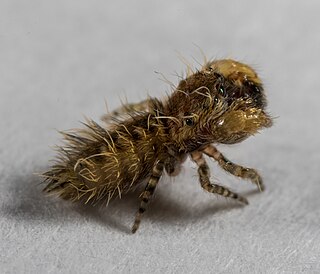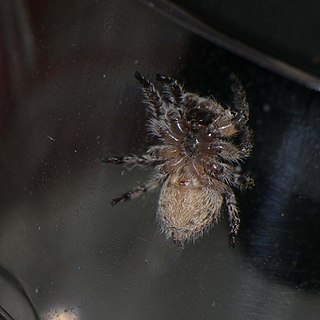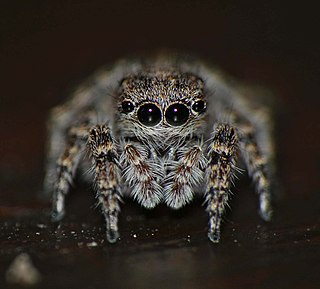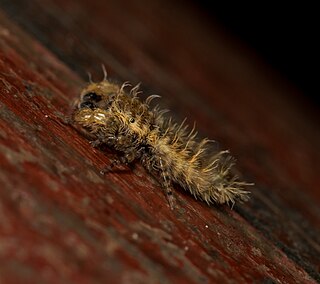Eupoa is a genus of spiders in the family Salticidae. Originally known only from one species from Vietnam, several other species have been described since 1997, all from Asia.
Gambaquezonia is a genus of the spider family Salticidae with two species. It was first described in some detail by Barrion & Litsinger (1995) from the female holotype, the only known specimen at the time. Its general appearance was later redescribed by Murphy and Murphy (2000).
Langerra is a spider genus of the jumping spider family, Salticidae.
Lechia squamata, synonym Laufeia squamata, is a species of spider of the family Salticidae. It is found in China and Vietnam. It was formerly the only species in the genus Lechia and was originally described from a single female, which was beaten from bushes in Vietnam.
Magyarus is a monotypic genus of Vietnamese jumping spiders containing the single species, Magyarus typicus. It was first described by Marek Michał Żabka in 1985, and is only found in Vietnam.
Paracyrba is a genus of jumping spiders found only in Malaysia. It contains only one species, Paracyrba wanlessi. Its microhabitat are the water-filled hollow internodes of decaying bamboo, where it preys for aquatic animals, especially mosquito larvae. P. wanlessi and Evarcha culicivora, a jumping spider, are the only two spiders that have been experimentally studied and considered a mosquito specialist. E. culicivora indirectly feeds vertebrate blood by preying female mosquitos that carry blood. In general only one specimen is found per occupied bamboo internode.

Uroballus is a spider genus of the jumping spider family, Salticidae. It includes seven accepted species.
Jerzego alboguttatus is a spider species of the family Salticidae. The species is only known from one immature female described in 1903 by Eugène Simon.
Stenaelurillus setosus is a possible species of jumping spider from Myanmar and Thailand. It was described from a single immature male specimen. Stenaelurillus setosus was regarded as a nomen dubium by the World Spider Catalog as of January 2021.
Uroballus octovittatus is a species of spider of the genus Uroballus. It is endemic to Sri Lanka.

Aelurillus brutus is a species of jumping spider in the genus Aelurillus that lives in Kazakhstan and Turkmenistan. The female was first identified by Wanda Wesołowska in 1996 and the male by Galina Azarkina in 2003. The spider is small with a carapace that is between 2.5 and 3.2 mm long and an abdomen between 2.4 and 4.7 mm in length. The female is larger than the male. The spider is generally dark brown and hairy, but the male abdomen has a pattern of grey-yellow wavy lines. The difference between this species and others in the genus are subtle. The females are particularly difficult to distinguish. However, there are three distinctive stripes on the eye field and a pattern on the bottom of the abdomen.

Mexcala macilenta is a species of jumping spider in the genus Mexcala that lives in Ethiopia and Tanzania. The spider was first defined in 2000 by Wanda Wesołowska and Anthony Russell-Smith. It mimics ants and ant-like wasps, living alongside and preying upon them. The spider is medium-sized to large, with a brown carapace between 3.2 and 3.4 mm long and a rusty-brown or greyish-russet abdomen between 3.2 and 5.5 mm long. The female is larger than the male. Both male and females have long thin brown legs and a distinctive pattern of a large triangular black marking in the middle of the abdomen. The male copulatory organs have a thin tibial apophysis and lack the triangular lobe on the palpal bulb that other species in the genus possess.

Hyllus rotundithorax is a species of jumping spider in the genus Hyllus that is endemic to Tanzania. It lives near rivers. The spider was first described in 2000 by Wanda Wesołowska and Anthony Russell-Smith. The spider is large, with a brown carapace 5.8 mm (0.23 in) long and an abdomen 6.8 mm (0.27 in) long. The species has a distinctive rounded thorax, after which it is named, and a long thin embolus. Only the male has been identified.

Langona fusca is a species of jumping spider in the genus Langona that lives in Zimbabwe. It was first described in 2011 by Wanda Wesołowska, one of over 500 that she has detailed. The spider is large, measuring 10 mm (0.39 in) in total length. Only the female has been identified. It has the toothless chelicerae typical of the genus. The epigyne, with its horse-shoe-shaped depression and looped seminar ducts, can help identify the species. The darker colour, which is referred to in the species name, is another distinguishing feature.

Langelurillus rufus is a species of jumping spider in the genus Langelurillus that lives in Ethiopia, Kenya and Tanzania. The male was originally described by Roger de Lessert in 1925 and named Langona rufa while male and female samples were named Langelurillus difficilis by Wanda Wesołowska and Anthony Russell-Smith in 2000. The species were combined with the current name in 2012. The spider is small, with a brown carapace that is between 1.9 and 2.0 mm long and an abdomen between 19 and 2.4 mm long. The female can be identified by the orange patches on its carapace. The spider has an abdominal pattern that helps distinguish the species from the related Langelurillus manifestus, which has a brown design on a yellowish abdomen with a brown design while Langelurillus rufus has a yellow design on a brown abdomen.

Langelurillus ignorabilis is a species of jumping spider in the genus Langelurillus that lives in Zimbabwe. The female was first described in 2008 by Wanda Wesołowska and Meg Cumming based on an example discovered with ten spiderlings. The male has not been identified. The spider is small with a dark brown carapace 2.7 mm (0.11 in) long and a brownish-grey abdomen 3.0 mm (0.12 in) long. It has short yellow legs. The species is similar to others in its genus and also member of the genus Langona, but differs in the design of the copulatory organs. For example, the seminal ducts are longer and have more loops than Langona bethae.

Phintella caledoniensis is a species of jumping spider in the genus Phintella that lives in New Caledonia. First described in 2009 by Barbara Patoleta, it was named after the island where it was found. The spider is small and has a brown cephalothorax with patches, the female being generally darker, and a grey or grey-brown abdomen. The female has distinctive bean-shaped spermatheca and the male a long and thin embolus.
Uroballus kinabalu is a species of spider of the genus Uroballus. It is endemic to the Malaysian part of Borneo.
Uroballus koponeni is a species of spider of the genus Uroballus. It is endemic to the Malaysian part of Borneo.

Uroballus carlei is a species of spider of the genus Uroballus. It is endemic to Hong Kong.








